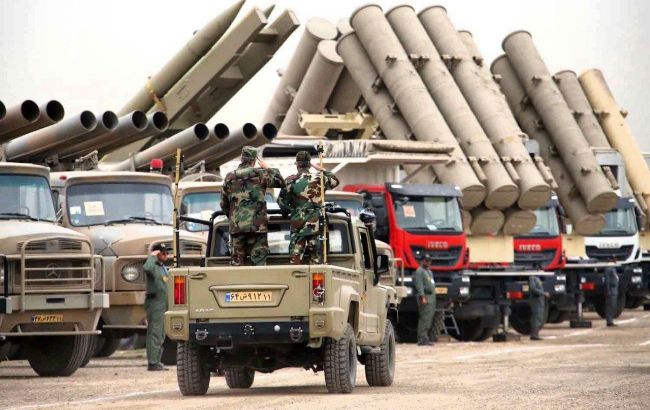S-300 and Iskander-M analogs: Danger of Iranian ballistic missiles in Russia's hands
 Photo: Iranian Fath-360 ballistic missile launchers (tasnimnews.com)
Photo: Iranian Fath-360 ballistic missile launchers (tasnimnews.com)
Western media are once again discussing the possible delivery of Iranian ballistic missiles to Russia. Ukraine's Western partners are reportedly concerned that the transfer may begin in the coming days.
RBC-Ukraine analyzes what kind of missiles Russia might receive and their danger.
Contents
- Is Iran ready to transfer ballistic missiles to Russia?
- What missiles Russia can get
- Danger of Iranian missiles in Russia's hands
Is Iran ready to transfer ballistic missiles to Russia?
According to Bloomberg, Ukraine's European partners do not rule out that Russia will soon receive ballistic missiles from Iran. Iran has previously assisted the aggressor with attack drones, but the transfer of ballistic missiles will be an even more disturbing event. The type, quantity, and exact timeframe of the delivery are still unknown.
Ballistic missiles are much faster than cruise missiles and can carry a much larger warhead. The United States and NATO allies have repeatedly warned Tehran against such a step. The US National Security Council, Iran's Foreign Ministry, and its mission to the United Nations did not respond to Bloomberg's request.
As winter approaches, Ukraine's rear cities and energy infrastructure are under systematic attack. On Monday, ballistic missiles attacked Kyiv in particular, the Mykolaiv region on Tuesday night, and a military communications institute and hospital in Poltava during the day (more than 50 people were killed and more than 200 wounded). This morning, aerial ballistic Kinzhal missiles participated in a combined Russian attack on Lviv, which also resulted in many casualties.
Russia's ballistic missile arsenal includes its own Iskander-M and North Korea's KN-23. They are launched from ground-based platforms in the border regions or on the occupied territories of Ukraine.
At the end of August, Iranian Foreign Minister Abbas Araghchi told European diplomat Josep Borrell that publications in the Western press about plans to transfer missiles to Russia were false. But judging by the dynamics of relations between Moscow and Tehran, these statements are not credible.
What missiles Russia can get
Talks about the transfer of Iranian ballistic missiles have been going on for a long time, recalls Valerii Romanenko, a leading researcher at the National Aviation University (NAU), an expert on aviation and missile weapons.
Reuters reported that Moscow and Tehran had reached an agreement back in the fall of 2022. Back then, the Russian side requested Fateh missiles, and the Iranians allegedly promised two or three batches. A year later, White House spokesperson John Kirby, commenting on the visit of then-Russian Defense Minister Sergei Shoigu, said there was a threat of a short-range ballistic missile transfer.
Citing several sources, in February 2024, Reuters reported the delivery of 400 missiles. The information has not been confirmed, and there have been no strikes on Ukraine by Iranian missiles since then. A month ago, the agency wrote that dozens of Russian missile specialists had been trained in the use of Fath-360 missiles.
According to Romanenko, the most likely types can only be discussed theoretically. “The ones that Iran will not feel sorry for Russia, because they seem to be preparing a strike against Israel. All long-range missiles will be directed there. But those that are unable to reach Israel, they seem to be ready to hand over to Russia,” the expert believes.
Thus, the interlocutor suggests focusing on five types of short- and medium-range missiles. The short-range missiles are Ababil and Fath-360, and the medium-range missiles are representatives of the Fateh family - Fateh-110, Zolfaghar, and Dezful.
Ababil is the latest development. The missile has a warhead weight of 45 kg and a maximum range of 86 km. The Fath-360 has a warhead of 150 kg and a range of up to 120 km.
The usual Russian Iskander-M has a warhead of 480 kg and a range of up to 500 km. Therefore, the Ababil and Fath-360 should be seen more as an analog of the S-300 anti-aircraft missiles that Russia uses to strike ground targets.
“The Russians need these missiles for more accurate shooting instead of anti-aircraft missiles. The S-300s also fly on a ballistic trajectory, but they land anywhere. The accuracy of Ababil and Fath-360 is considered to be higher, with a radius of circular deviation of less than 30 meters,” Romanenko explains.
The Fateh-110 has a 400-500 kg warhead and a claimed range of up to 300 km. Zolfaghar hits further and more accurately, its warhead weighs 579 kg and has a range of 700 km. The longest range of the five types is the Dezful with a 700 kg warhead and a range of up to 1000 km.
The Fateh-110 and Zolfaghar are closer to the Russian Iskander-M. According to the source, the Zolfaghar may turn out to be much worse, and not only because its warhead is 80 kg heavier.
“At the terminal section, when it falls almost vertically, the warhead separates and the body flies by itself. The warhead is smaller than the body, and it is more difficult to shoot down with a direct hit. In this regard, even Iskanders with a one-piece body is easier for us to intercept,” he emphasizes.
As for Dezful, there is less information about it. But in general, the expert community is inclined to believe that the declared tactical and technical characteristics of Iranian missiles may be advertising and not correspond to reality. “Most of the data provided is approximate,” Romanenko adds.
Danger of Iranian missiles in Russia's hands
The purchase of the Ababil or Fateh-360 will allow Russian troops to strike more targets in the near rear. At the same time, it will maintain stockpiles of missiles of its production for targets in Ukraine's deep rear, analysts at the American Institute for the Study of War (ISW) note.
According to Romanenko, these Iranian missiles will be used in frontline cities and will be able to reach almost Poltava. “The declared radius of the Ababil of 86 kilometers includes many large settlements. Fateh-360 has a range of about 120 km. That is, they will all fly over our poor cities, which are getting the full measure of the S-300,” he says.
The Russians' desire to get Iranian missiles is related to problems with their production. Iran, on the other hand, will not miss a chance to make money, as it did with the Shahed. After Moscow launched the production of Shahed analogs, it turned out that they were 2-3 times cheaper.
“Russians are ready to buy missiles for any money from any dictatorial regime. They are unable to provide Iskanders to achieve their strategic goal of destroying Ukrainian infrastructure. They need Iranian missiles to keep our air defense system in constant tension and our economy under constant attack,” the expert says.
According to him, Russia is currently doing everything to reach the possibility of solving strategic tasks through modern non-contact warfare.
“When the fighting at the front is of a deterrent nature, and the main battle is fought with long-range strikes on industry and control centers. The Russians have been trying for 2.5 years, and it hasn't worked. Now they are assembling missiles wherever they can,” Romanenko adds.
Sources: Open data, Bloomberg, Reuters, and comments by Valerii Romanenko, an expert on aviation and missile weapons.

